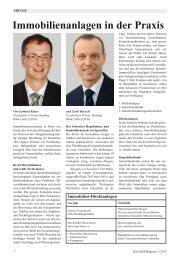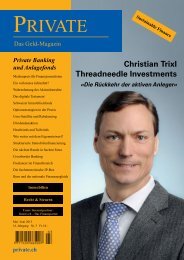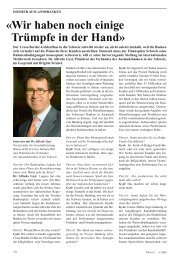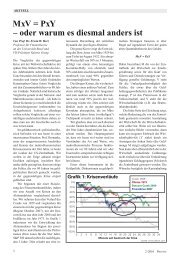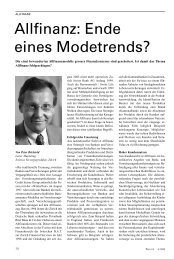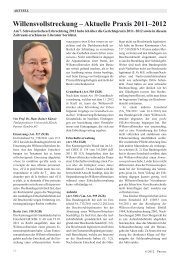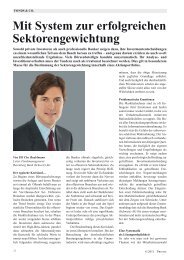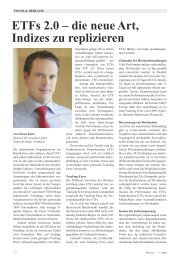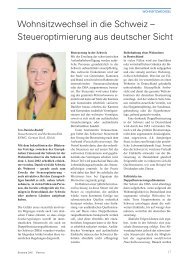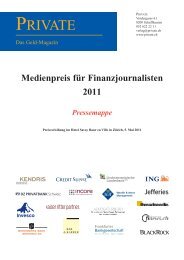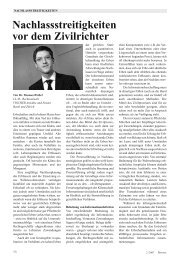PDF - Private Magazin
PDF - Private Magazin
PDF - Private Magazin
Erfolgreiche ePaper selbst erstellen
Machen Sie aus Ihren PDF Publikationen ein blätterbares Flipbook mit unserer einzigartigen Google optimierten e-Paper Software.
triggers for major central banks to inject<br />
this drug in the future. We think<br />
that a rise of the weighted average of<br />
10-year Spanish and italian bond<br />
yields to around 7% could trigger such<br />
an action by the eCB. in the U.S. the<br />
triggers are less easily defined, given<br />
the diverging opinions within the Fed.<br />
However, it is likely that a significant<br />
slowdown of the U.S. economy will<br />
cause the Fed to start a third round of<br />
Qe. For example, when payrolls fall to<br />
100,000 and/or the iSM Manufacturing<br />
index falls to 50, the signs for Qe<br />
will likely turn green.<br />
What are the implications<br />
for investors?<br />
Given the lack of alternatives, it is likely<br />
that new rounds of Qe and the associated<br />
“risk-on” and “risk-off ” periods<br />
will dictate investor behaviour for<br />
some time to come. this has a few important<br />
implications. Firstly, it means<br />
that investors have to be very alert and<br />
nimble, even more so than in the past.<br />
alternatively, they can adopt a very<br />
long investment horizon of a decade or<br />
more, which gives them a good likelihood<br />
to fully capture the premium<br />
yields which risky assets still offer.<br />
Secondly, investors have to realise that<br />
correlations of risky assets in “riskoff<br />
” periods may remain very high. in<br />
other words, when markets become<br />
nervous there are very few places to<br />
hide. Only government bonds of the<br />
strongest countries, securities of the<br />
most defensive multinationals and certain<br />
commodities have proven to be<br />
real safe havens.<br />
What kind of risky assets<br />
do we prefer?<br />
Let us first look at equities. For 2012 as<br />
a whole, we expect corporate earnings<br />
to be roughly flat for U.S. companies<br />
and to decline moderately for european<br />
companies. the core reason for<br />
this slowdown is declining revenue<br />
growth; a direct consequence of lower<br />
global growth combined with diminishing<br />
profit margins. However, compared<br />
to previous recessions we only<br />
expect a moderate profit decline this<br />
time. Companies do not struggle with a<br />
big inventory overhang or excess capacity.<br />
On top of that, they have not<br />
added a lot of “fat” during the latest<br />
recov ery. Costs are kept well under<br />
control, which makes companies’ earnings<br />
more resilient to a downturn in<br />
revenues. in general, companies are in<br />
good shape. Balance sheets are strong<br />
and profit margins have been largely<br />
restored to pre-Lehman levels and this<br />
despite the below-par economic recovery<br />
we witnessed over the past two<br />
years.<br />
Current equity valuations already<br />
reflect many uncertainties. From a historic<br />
point of view, the trailing price/<br />
earnings ratio for global equities is<br />
more than 1 standard deviation below its<br />
40-year average. in europe, the valua -<br />
tions relative to the government-bond<br />
markets are close to the levels reached<br />
in the aftermath of the Lehman crisis.<br />
Of course, this has as much to do with<br />
low bond yields as with cheap equity<br />
valuations. in a low-growth or recessionary<br />
environment, bond yields and<br />
equities move in the same direction.<br />
We will, of course, observe big divergences<br />
between companies. those<br />
heavily dependent on european sales<br />
and a high commodity input will undoubtedly<br />
suffer most; especially as<br />
emerging-market growth is likely to<br />
keep commodity prices high. inter -<br />
nationally, emerging-market-exposed<br />
companies will fare better. We gener -<br />
ally prefer the big multinational companies<br />
in sectors such as technology,<br />
energy and consumer goods (with a<br />
limited cyclicality) for the long term.<br />
in an environment where there is limited<br />
room for profits to rise, we focus on<br />
high, stable and well covered dividends<br />
as an attractive source of income.<br />
For bond investors, as for equity<br />
inves tors, the potential for significant<br />
price gains has become limited. therefore,<br />
the annual income generated by a<br />
AKTUELL x<br />
bond investment has gained in importance.<br />
in this sense, emerging-market<br />
debt (in hard currency) is still one of<br />
our preferred asset classes. in general<br />
and despite recent doubts, prospects<br />
are better for emerging markets than<br />
for developed markets. We think that<br />
emerging markets will perform in line<br />
with their superior fundamentals (low<br />
indebtedness, high growth, vast countercyclical<br />
ammunition, attractive valuations<br />
etc.). a necessary condition for<br />
this is a soft landing in China. Lately<br />
some doubts were popping up and fears<br />
of a hard landing crept into investors’<br />
minds. We nevertheless think that<br />
China is still on track for a soft landing<br />
and that it will ease policy if necessary.<br />
a failure on this front would be very<br />
detrimental for cyclical assets and<br />
would limit the much-needed growth.<br />
We also like high-yield bonds, an<br />
asset class which is dominated by midsized<br />
U.S. corporates. investors are still<br />
relatively well rewarded for the risk<br />
taken in this asset class. as stated before,<br />
corporate balance sheets are in<br />
good shape and the risk of a deep U.S.<br />
recession and high corporate default<br />
levels is limited, given the fact that the<br />
Fed will initiate new rounds of Qe as<br />
long as necessary.<br />
Having said this, we are still living<br />
in an environment where investors have<br />
to deal with short and intense cycles.<br />
Effective risk diversification can only<br />
be realised when also holding some<br />
low-yielding government bonds. even<br />
so, the rewards for taking risk are still<br />
substantial. after all, risky assets offer<br />
attractive yields and some protection<br />
against inflation for those who fear it.<br />
We do not, yet.<br />
ad.van.tiggelen@ingim.com<br />
www.ingim.ch<br />
Effective risk diversification can only be realised when also<br />
holding some low-yielding government bonds. even so, the rewards<br />
for taking risk are still substantial. after all, risky assets<br />
offer attractive yields and some protection against inflation for<br />
those who fear it. We do not, yet.<br />
<strong>Private</strong> 3/2012 11




